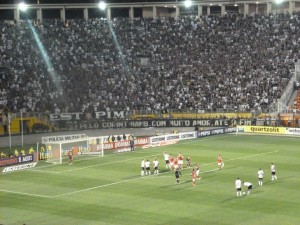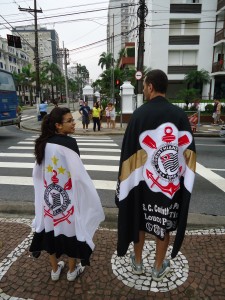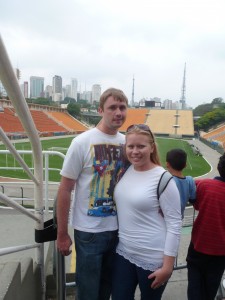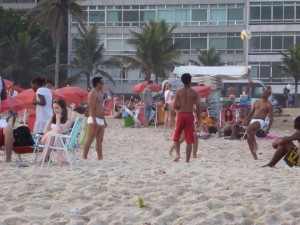“It is nice to meet you. I’m the President of the United States. You don’t have to introduce yourself because everyone in the world knows who Pelé is.” – President Ronald Reagan

As we drive through the streets of São Paulo, we often encounter a futebol (soccer) pickup game being played in the center of the streets. Slowly navigating around the goals and watching for any sudden movement of ball or kids toward the car, we steer past. These street games are often played in the poorer neighborhoods while middle to upper class neighborhoods have walled fields on the sides, always busy with action. Games are ubiquitous in Brazil all seven days of the week. The streets are slightly quieter on Wednesday and Sunday when professional teams take the field and people meet with their friends around televisions and bottles of Original or Skol cerveja (beer), intermittently singing the anthems of their teams.
This weekend, most of the nation awoke to cheer for or against Corinthians, the most popular yet possibly also the most hated futebol club in Brazil. Corinthians fans had been building this game up for months, held at a neutral site in Japan and considered the world championship of club soccer, between Chelsea of England and Corinthians of Brazil. Fans of rivals purchased and downloaded Chelsea emblems throughout the week as the easiest manner to display their hatred.

We spent the weekend in Santos, the busiest container port town in Latin America, about a one-hour drive (or possibly 8-9 hours with potentially horrible Brazilian traffic) from the city of São Paulo. After the first half, with the game tied at 0-0, it was difficult to decipher whether the citizens of Santos, where football’s most famous star, Pelé, spent his career on the local club team and Brazilian star Neymar now plays, cared about the game occurring for São Paulo’s top team. After all, their own team was recognized by FIFA as being the first professional team in the world to score 10,000 goals.
However, when Paulo Guerrero received a pass behind the goalkeeper in the second half of the game and placed it in the goal above the heads of three Chelsea defenders attempting to cover the goal for their displaced goalkeeper, the fireworks literally began filling the Brazilian landscape. Throughout the final moments of the game, fireworks and car horns became increasingly louder, predicting the post-game party that we would soon witness. As the game’s final whistle blew, our friends from Santos recommended a walk to the town’s central meeting place where Corinthians celebrators would be converging.
Along our walk to the center of town, car horns blared, flags waved and Corinthians fans sang their anthem. As we approached, we saw a growing crowd shouting, jumping and shooting fireworks. What we witnessed was a slightly smaller scale version of the massive celebrations being broadcast on television from the city of São Paulo.
Futebol rivalries in Brazil dwarf any rivalries that we have previously witnessed, including Yankees-Red Sox and Auburn-Alabama. The threat of violence is so real that the visiting team at South American soccer matches is released from the stadium first and given up to an hour at times to vacate the premises before the home team’s crowd is allowed to exit. Alcohol is not sold at professional soccer matches in South America in an attempt to further discourage violence.
On a national level, Brazil maintains a fierce rivalry with Argentina. Whether the national teams are playing or two club teams from each country are facing off, fireworks are likely. Last week, São Paulo FC faced Tigre from Argentina in the championship of Copa Sudamericana. The game, held in São Paulo, was suspended at half-time with SPFC leading 2-0 and declared the champion. Tigre’s coach had refused to allow his team to retake the field, citing first half violence and claiming that São Paulo police pulled guns on his players as they entered the locker room. This is certainly not the first occurrence of such actions at a Brazilian match. In 2005, a player from the Argentine team of Quilmes was arrested on the field for alleged racism and detained for 40 hours. Charges were later dropped. In 2002, Santos defender Preto was left unconscious after being hit in the head by a police officer while arguing with a referee. Other incidents have also occurred where players were pepper sprayed or arrested during matches.
Despite a record five World Cup championships, past losses continue to sting in a nation that fully expects to win each and every year, and the nation’s winning history is often overshadowed by the losses. Alcides Ghiggia’s goal for Uruguay in 1950 is displayed throughout São Paulo’s Museu do Futebol and still often arises in conversations 62 years later. An Olympic gold medal has still evaded Brazil and this year’s loss to Mexico in the championship once again hurt in a nation that fully expects to win.
The city of São Paulo, our current home, has three major professional football teams: Corinthians, São Paulo and Palmeiras.

Corinthians, now labeled as this year’s World Champion, is the “people’s favorite.” This team has cheaper tickets than its rivals and claims fans across favelas throughout Brazil. Only Flamengo in Rio de Janeiro can claim nearly as many fans as Corinthians nationwide. The team currently plays in the city’s shared stadium of Pacaembu but is now building its own world-class stadium ahead of the 2014 World Cup.
São Paulo FC has higher priced tickets and tends to hold more of an upper class fan base. Their rivalry with Corinthians remains fierce and shouts of opposing chants and anthems occur everywhere that fans may clash.
Palmeiras is the third professional team in the city of São Paulo. In recent years, Palmeiras has struggled and will fall to the second division for a second time next year. This has resulted in death threats to the team president from avid fans. Palmeiras fans lately have had more fun cheering for the opponents of Corinthians and São Paulo than cheering on their own team. Meanwhile, Corinthians fans are openly just as happy about Palmeiras’ demise as they are their own success.
Since being brought to Brazil by British visitors in the late 1800s, futebol has evolved this culture in a way that will be seen on the world stage as never before during the 2014 World Cup and 2016 Summer Olympics. Pictures of Pelé and Neymar occupy about half of the advertisements seen as we travel around São Paulo state. Pelé is often regarded as Brazil’s ambassador to the world. In fact, when he arrived in the United States to play for three years, the number of registered soccer players in the United States almost quadrupled. However, star soccer players are also one of Brazil’s most profitable exports. Most players head to Europe, financially benefiting themselves and their teams. Some teams exist solely to develop and sell rising stars. Today’s leading star, Neymar, has promised to stay in Brazil until the World Cup in 2014, later than most stars stay in the nation today. Chelsea’s roster currently includes three Brazilians. Still, with or without its top stars, Brazilian culture will continue to depend on futebol.

The most popular sports and games all include elements of soccer. On the beach, teens play with makeshift goals while older adults juggle the ball in groups. Volleyball courts are often used for futevolei, and futsal is a popular variant played on an indoor court. We should soon see futelama (mud football), popular on the banks of the Amazon. Alex Bellos even describes a variant of demolition derby, autoball, played with a 7 football and cars, in his book “Futebol: The Brazilian Way of Life.”
Many say that two religions exist in Brazil: Flamengo and Corinthians. On Sundays, their fans meet with the fervor and rituals as elaborate as any organized religion. They shed tears and laughter while loudly rooting on their favorite teams and pointing out on-the-field lessons to their offspring, the next generation of soccer players. Even the economy here is said to depend on the success of the Brazilian men’s national team. It is impossible to describe Brazil without including Brazilian football. Brazilian futebol is Brazilian culture.
-Chris

Great article, Chris. Thank you.
Thanks for reading and commenting, Jason. Hope you’re doing well out West. How is the new job?